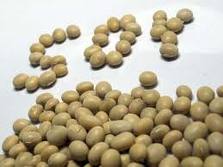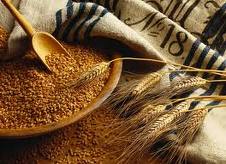
Synthetic Foods—
How Healthy?
Synthetic foods are rarely, if ever, of exactly the same composition as the original. For some time man has attempted to create artificial food from petroleum, atmospheric nitrogen, natural gas, and even sewage and sludge. Indeed, man has succeeded in manufacturing many fabricated foods today. We cannot help but wonder what new disease may grow out of the use of these synthetic foods. When mankind competes with the real thing in the blending of food elements he needs to be sure that his fake food mixtures does not bear the skull and crossbones.
After World War ll, when snails were in short supply, French chefs improvised with waste rubber reduced to a powder, mixed to a paste, molded into snail shape, and soaked in a liquid. These “snails” were inserted into real snail shells and served with garlic butter. Many Frenchmen were fooled.
Today, food technologists have produced simulated meats, poultry, fish, eggs, dairy products, vitamins, etc.
NATURAL VERUS SYNTHETIC
Few people have given it much thought to the amount of synthetic foods they consume. We are already well along on this road to synthetic foods. A case in point is the use of synthetic vitamin C, or ascorbic acid.
Many experimental reports show that ascorbic acid consumed in its natural medium(citrus juices, leafy greens, etc.) is better utilized under certain circumstances (scurvy) than the synthetic form.
In animal experiments, synthetic ascorbic acid failed to cure scurvy in a litter of puppies, whereas fresh orange juice resulted in “spectacular recovery.” Russian investigators reported natural vitamin C more effective in preventing scurvy and hemorrhage in guinea pigs than the synthetic product.
IMITATION MILK AND NONDAIRY WHIPPING CREAM
Imitation milk consists of water, corn syrup, vegetable oil(commonly hydrogenated coconut oil), sodium caseinate (derived from soybeans or milk), potassium phosphate, salt, stabilizer, emulsifier, artificial coloring and flavoring, and synthetic vitamins and minerals. Non dairy whipped topping is even worse.
The producers of these products claim that these items have certain advantages over cow’s milk. Flavor stability is easier to control. It has a longer shelf life and is less vulnerable to the action of micro-organisms. It meets Jewish dietary laws. And above all, is cheap to produce.
Imitation dairy products have been touted as being without the highly saturated butterfat of milk. True! But in imitation dairy foods the butterfat is replaced with coconut oil which is also highly saturated. Coconut oil or hydrogenated fats may be used in nondairy cream substitutes. When analyzed, these products contained a higher percentage of saturated fatty acids that that found in milk fat.
Imitation dairy products were judged to be potentially harmful for vulnerable age groups such as pregnant and lactating women, and persons on marginal diets such as those in low-income groups and the aged. Nutritional investigators unanimously agreed that “the imitation milks and certain filler milks as formulated today are unsuitable for infants and children.
Why take any risk at all with these synthetic dairy products?
WHAT ABOUT MARGARINE?
Margarine is often advertised as being “made from polyunsaturated oils.” But manufacturers neglect to mention that the oil is changed into margarine by saturating it with hydrogen.
Once a vegetable oil has been hydrogenised a “new” fat has been created. Research is now showing that the body does not have the capacity to deal efficiently with the essentially synthetic food or any artificially hydrogenated vegetable fat. In fact, there are elaborate statistical analysis of the incidence of heart diseases in relation to the consumption of hydrogenated fats. Where margarine and solid vegetable shortenings were used in significant quantities, the rate of heart attack was always higher than where they were not used.
It is bad enough that with every mouthful of hydrogenated fat we also get a quantity of nickel.
When you use margarine or other hydrogenated fats here is what you will be getting for your money in most cases:
Benzoate of soda
Dyes and other coloring matter
Artificial flavoring
Artificial vitamins
Saturated fats (hydrogenated fat)
Pulverized nickel
Fragmented aluminum
Other additives
For the over 3,000 million pounds of margarine sold, somebody had to supply 25 trillion units of synthetic vitamin A and D, 4 million pounds of mono-and diglycerides, 37.7 million pounds of salt, 300,000 pounds of artificial flavor and coloring agents, 1.8 million pounds of sodium benzoate, and 2.8 million pounds of lecithin.
At present, there is no control over most of the additives used in margarine. Anti-oxidants are used to improve shelf life, and anti-microbial agents also may be added.
ANALOGS—“MEATLESS MEATS”
They call analogs a delicious alternative to meat. Analogs are textured vegetable proteins made from soy or wheat products.
When you learn how the “meatless meats” are manufactured, you see a sci-fi picture begin to emerge.
The beans (soy) are first dehulled and put through a series of rollers, a process that turns them into flakes. Bathing these in hexane, a hydrocarbon solvent extracts their oil, but not 100 per cent.
Heating the oil/hexane mixture is suppose to drive off the hexane. The oil-a by-product of the synthetic meat manufacturing process—is widely used for cooking purposes.
The flakes are then ground into a flour. The final product is an isolate, a powder that is 90% protein.
The spun liquid protein is pressure-fed through a die that has about 15,000 tiny holes. The solution then goes into an acid bath, where it congeals into protein threads.
The hardened threads are drawn off and stretched to give them greater strength. A section of protein threads, called a tow is cut into short pieces and then mixed in a large vat with binders, flavors, coloring, and synthetic nutrients. Finally the mixture is put into molds, pressure-cooked, and sliced.
One manufacturer of these products adds monosodium glutamate (MSG). They say: “while there are those who erroneously believe this amino acid derivative to be both a preservative and harmful, it is only used as a flavor enhancer. It has no preservative action, and is metabolized like other amino acid derivatives. MSG has been extensively tested and scientifically proven safe for human consumption.
(Editor’s note: the last sentence is a false statement and we recommend that you read tract number 20, Monosodium Glutamate).
Soy bean and wheat analogs have no connection whatsoever with good wholesome soybeans, or wheat in their natural state.
At least 90 per cent of all the soy bean products sold throughout America are made from soy bean residues that have been treated with hexane gas and are harmful to man and beast.
THE MAD CHEMISTS!
Our intake of synthetic foods saturated, hydrogenated, and imitation dairy products is the world’s highest. We lead in eating factory-processed foods (flake foods, baked, boxed, canned, precooked, preserved, and frozen), containing thousands of chemical preservatives and additives.
The twentieth century has brought us food products developed in chemical laboratories.
Is a natural substance from plants more safe than the chemical combinations from a laboratory? Why of course it is!
The manufacturers of synthetic foods advertise their products as “fortified” with synthetic vitamins and minerals and they claim they are abundantly nutritious because they are enriched. The consumer would be far ahead to gain these nutrients in fresh fruits, fresh vegetables, and whole grains rather than in the food made in laboratories to which they have been artificially added in small amounts.
Even real bread, in most cases, has been taken out of our mouths. The mad chemists crush the wheat with rollers that destroys the cellular structure of the grain and changes it biological pattern, even boxed cereals have been mauled by being shredded, crinkled, popped, and puffed. Many of these cereals contain more sugar than grain. Gradually a basic grain has undergone such modification that it has been transformed into a confection.

Consumer beware of synthetic foods!
Hydrogenated oil is a synthetic chemical compound or plastic. There is neither justification, rhyme nor reason for calling it an oil or fat. It is no more an oil suited for human consumption than is celluloid or motor oil or plastic.
Whether therefore ye eat, or drink, or whatsoever ye do, do all to the glory of God.
1 Corinthians 10:31
Katy Chamberlin